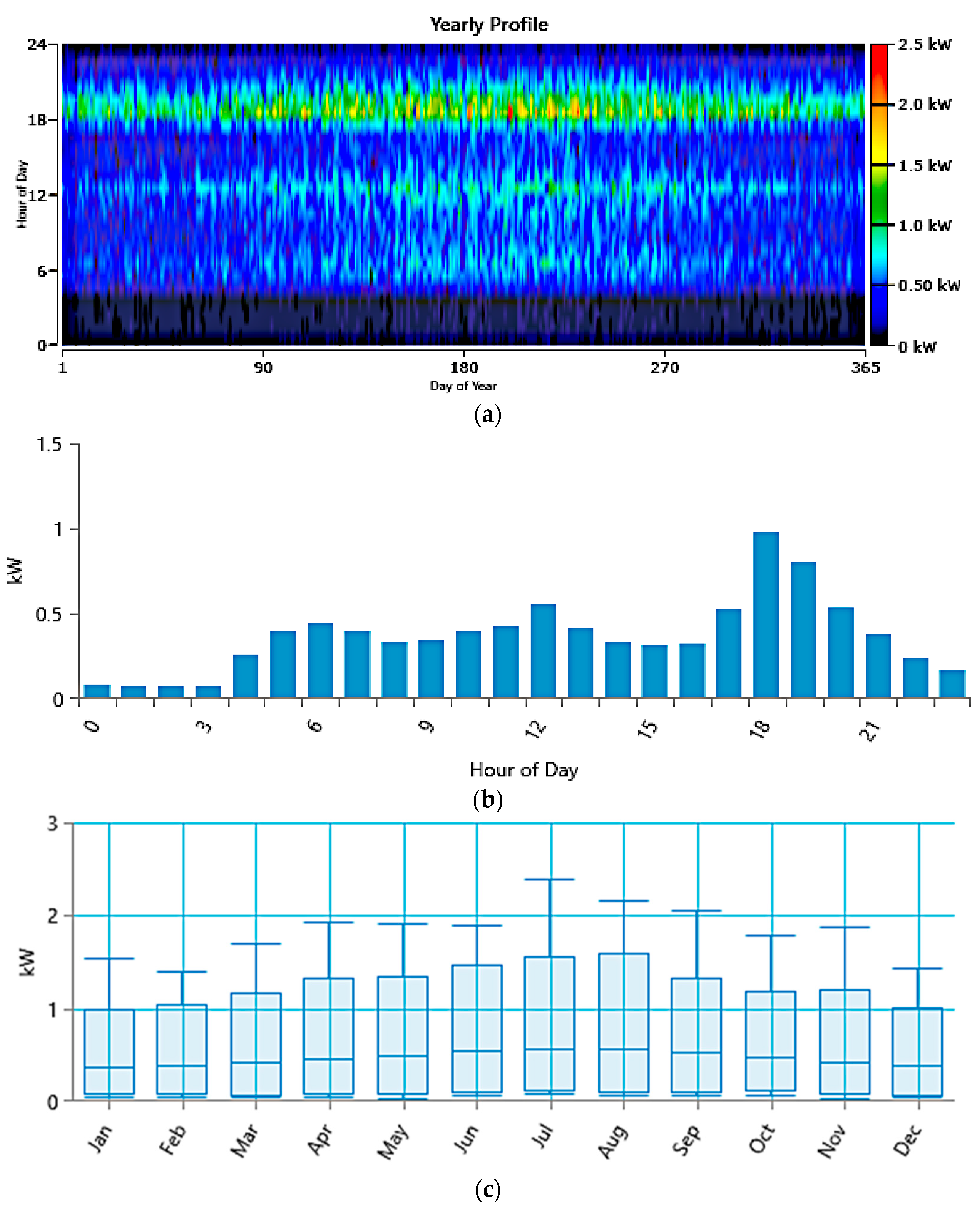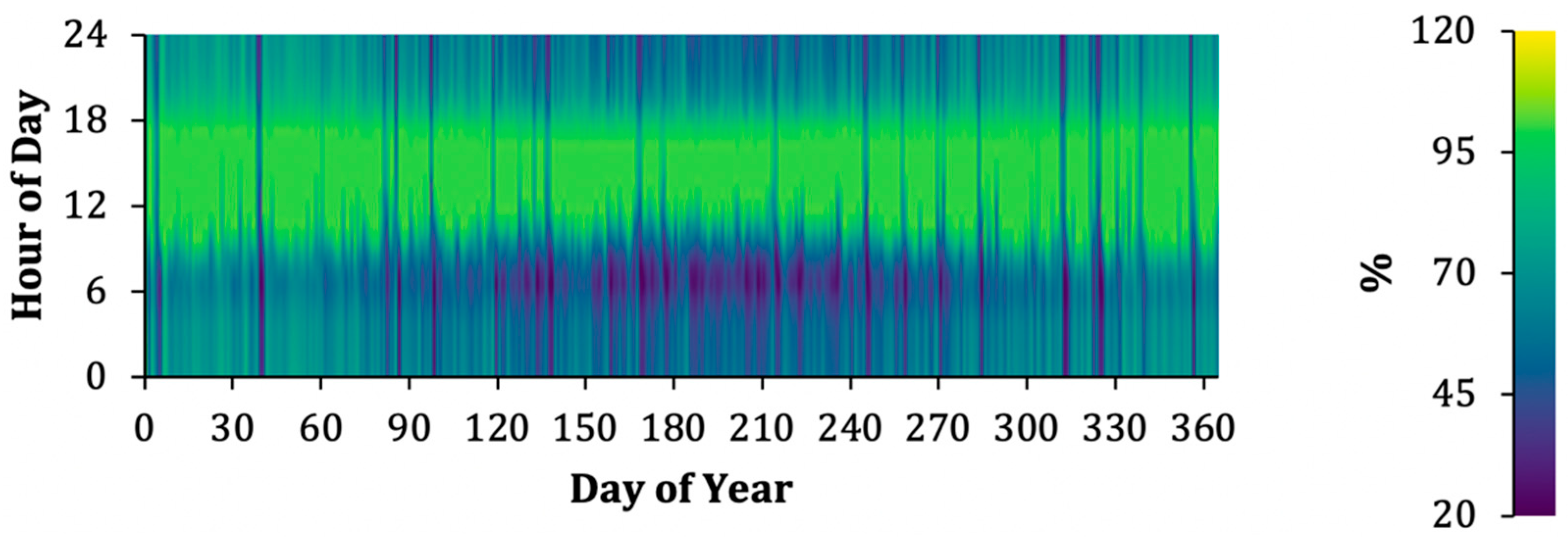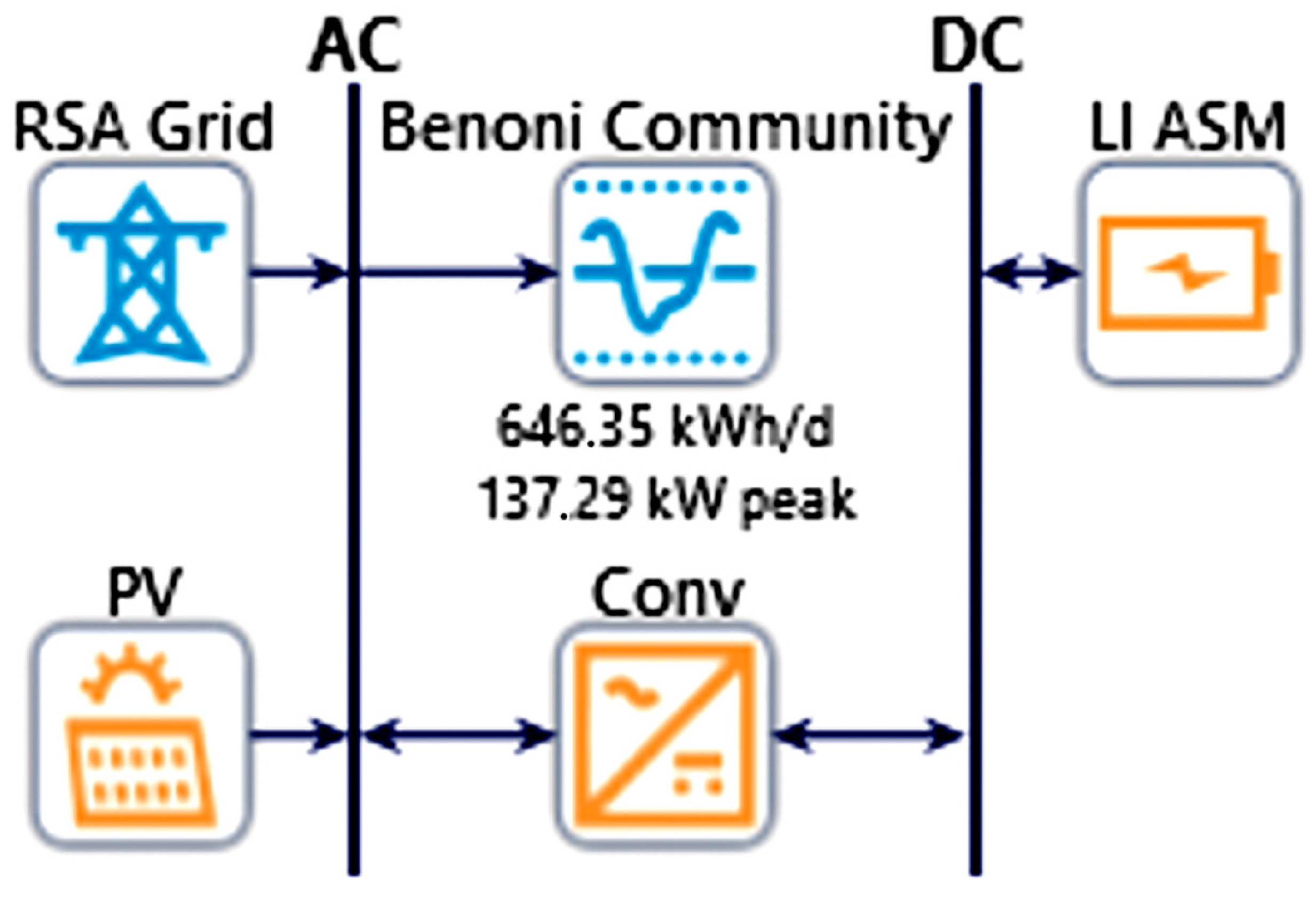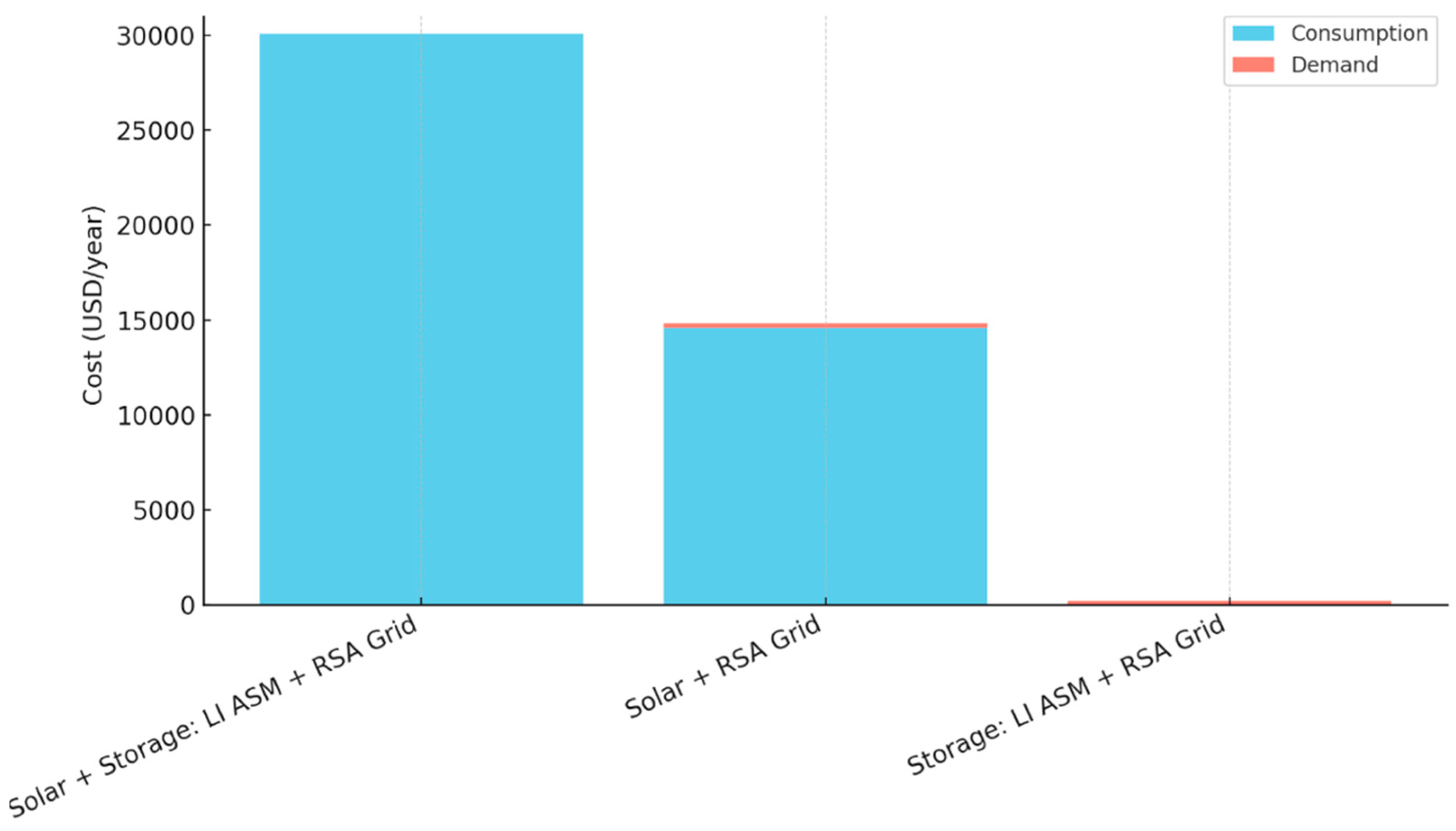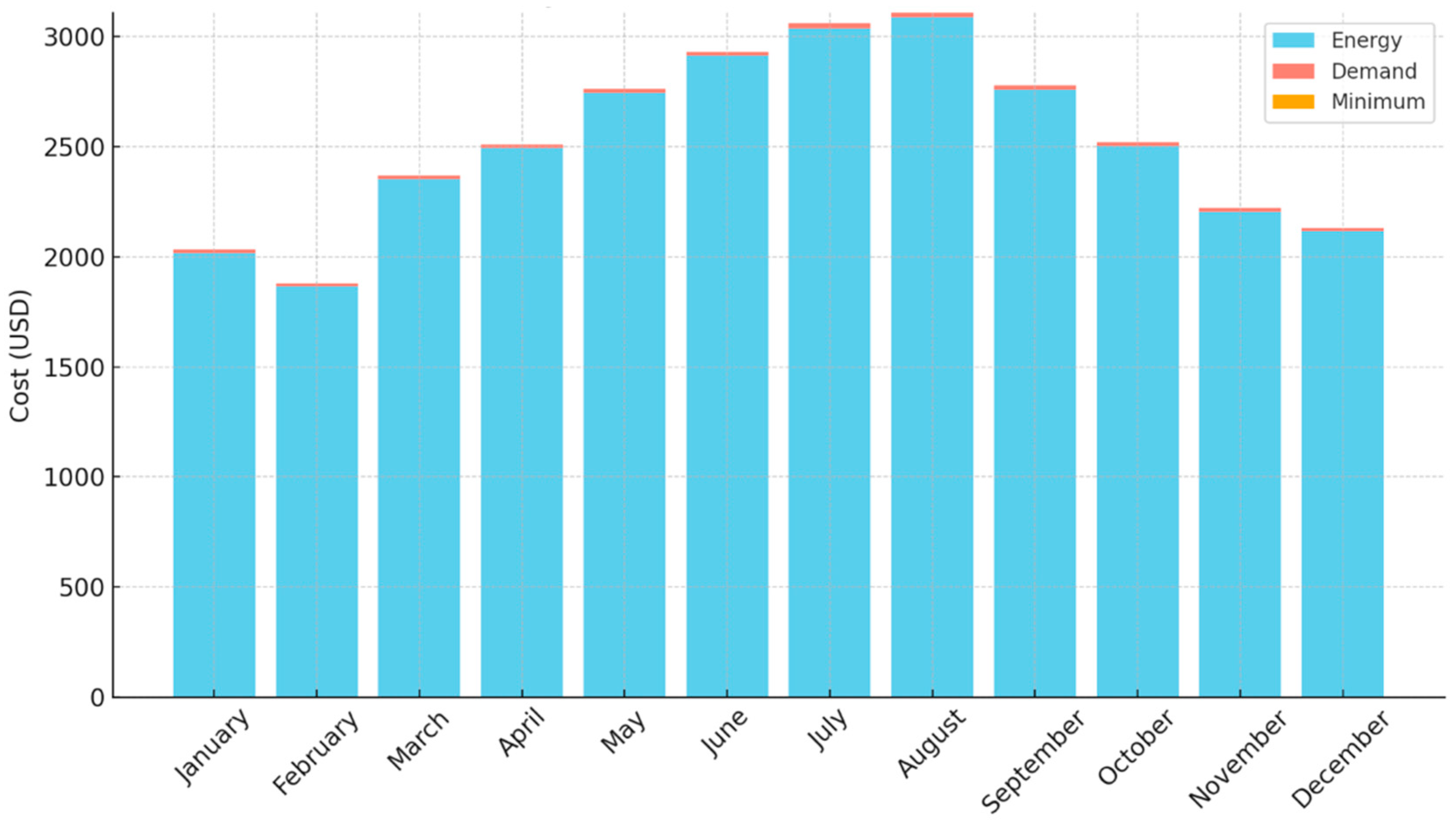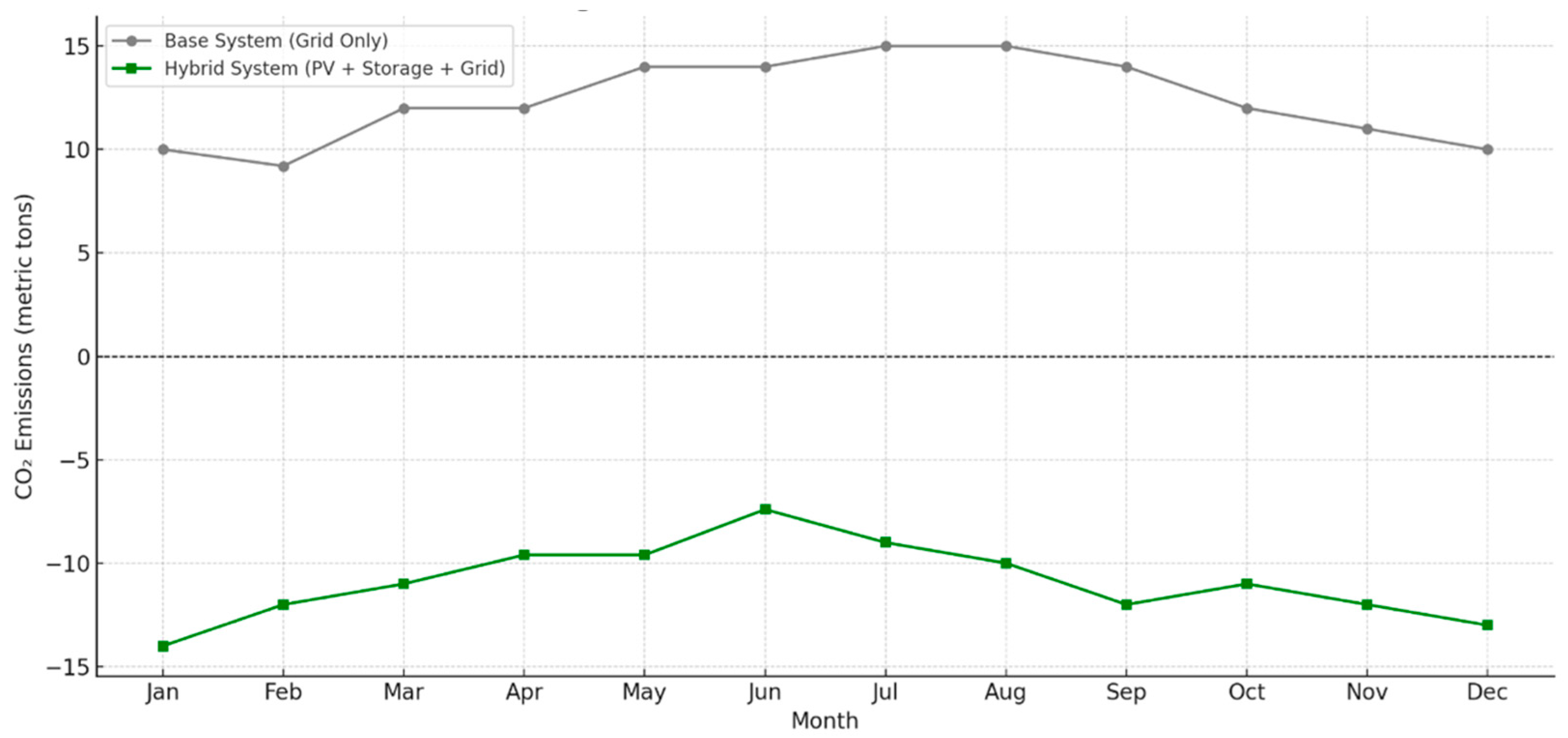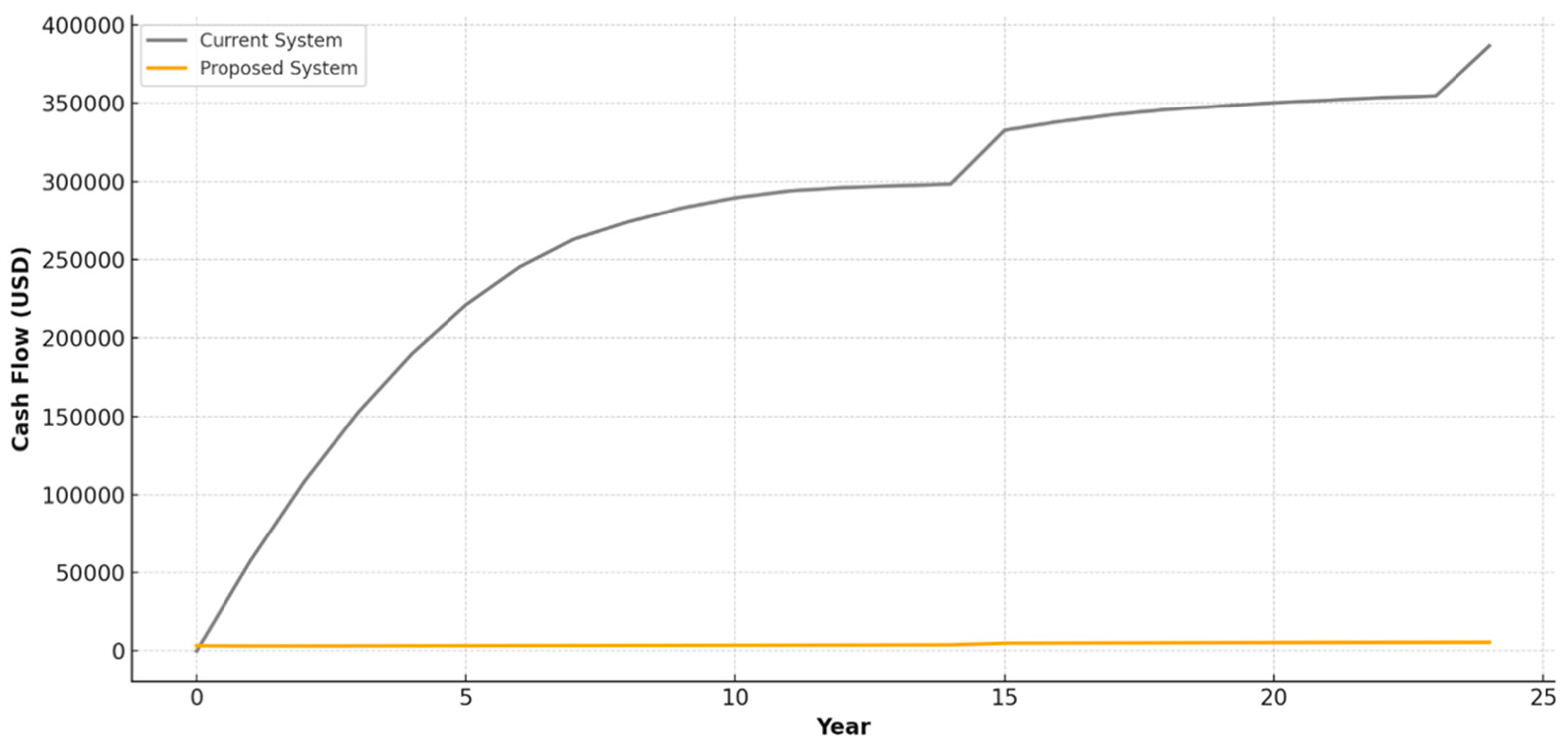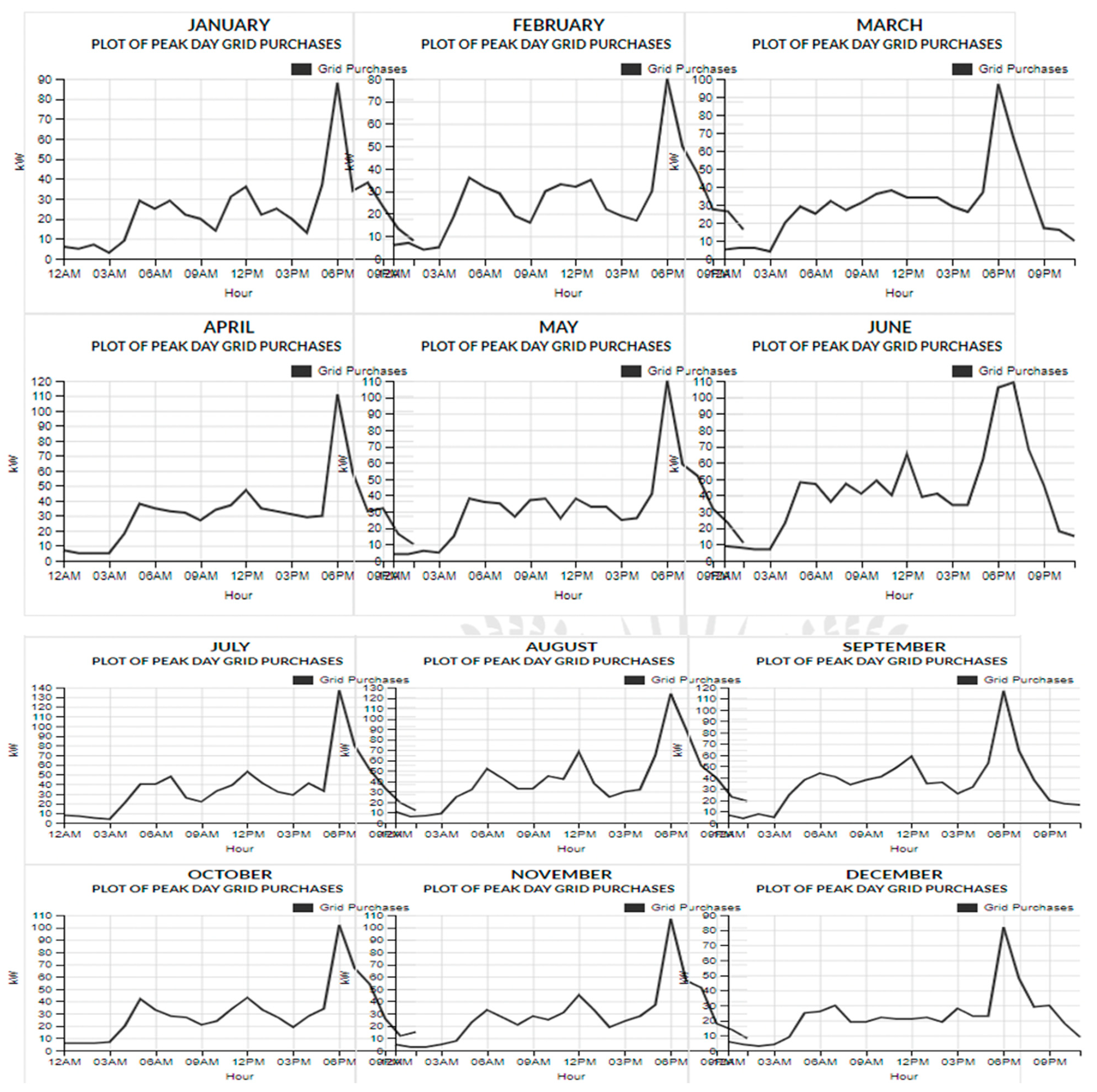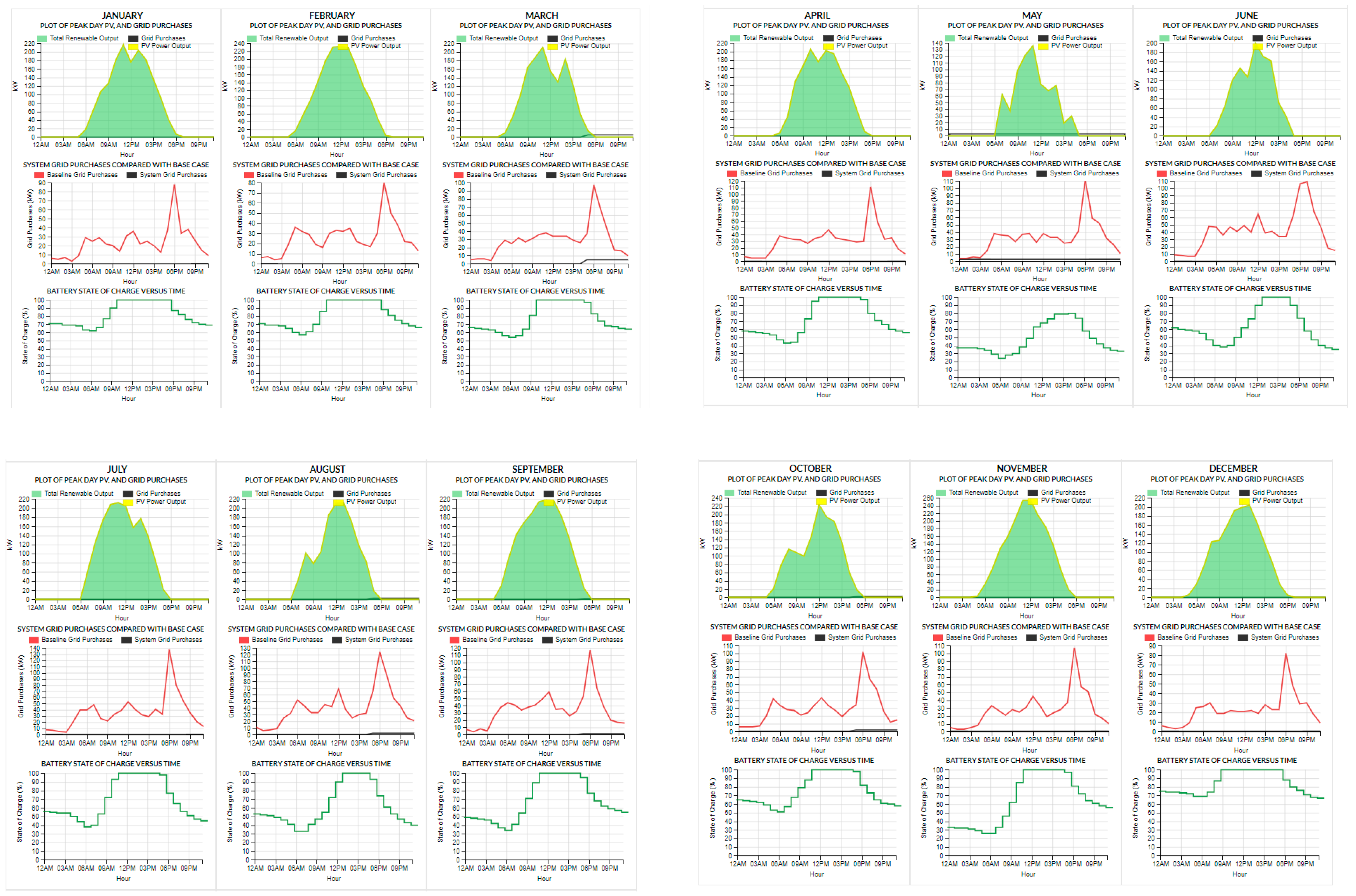1. Introduction
Photovoltaic (PV) solar energy refers to electricity generated directly from sunlight using solar panels. It offers a cleaner and more affordable alternative to conventional electricity generation methods [
1,
2,
3,
4,
5]. However, solar power is inherently weather dependent and cannot produce electricity in the absence of sunlight, such as during nighttime or overcast conditions [
5,
6,
7]. The core components of a typical solar PV system include solar panels, charge controllers, inverters, and batteries [
3,
5,
6,
8,
9,
10,
11,
12,
13,
14,
15,
16,
17]. In South Africa, a primary driver for the adoption of solar PV technology is the recurring issue of loadshedding, wherein electricity is intermittently turned off by the national utility, Eskom, due to supply shortages. Grid integration of PV systems raises concerns for Eskom, particularly around transient energy losses and phase imbalances introduced by distributed solar generation [
18,
19].
The over-reliance on fossil fuels contributes significantly to global warming and public health issues [
10,
13,
20]. Consequently, many countries—including South Africa—are actively pursuing alternative, sustainable energy sources such as solar and wind [
7,
9,
10]. Environmental scientists have raised concerns about the long-term consequences of fossil fuel use, including ecosystem degradation and atmospheric pollution [
1,
2,
4,
11,
21,
22]. In addition, projections indicate that global reserves of coal and natural gas may be exhausted in approximately 107 and 37 years, respectively [
11,
12,
23]. PV systems do not generate electricity at night, as they rely solely on sunlight intensity [
12]. Nonetheless, they offer a low-emission solution, significantly reducing pollution and greenhouse gas output compared to fossil fuel-based energy systems [
10,
11,
12]. Solar energy also contributes to energy security by reducing dependence on imported fuels [
12,
18,
24]. In regions with high electricity demand and unreliable grid access, PV systems provide a practical and scalable solution.
In the South African context, solar PV is expected to play a pivotal role in the future energy mix [
13]. Large-scale deployment has led to reduced production costs, largely due to technological advancements and economies of scale [
14,
23]. However, end-of-life disposal of solar panels poses environmental risks. As installation rates rise, effective recycling and waste management strategies will become increasingly important [
5,
6,
7,
8,
9,
10,
11,
12,
17]. Despite their advantages, rooftop solar PV systems face several technical challenges. These include manufacturing defects; faults in components like fuses, junction boxes, and charge controllers; and issues with grounding and wiring [
8,
10,
15]. Earlier generations of solar panels also suffered from degradation of the ethylene vinyl acetate (EVA) anti-reflective layer and cracking of solar cells [
18,
23,
25].
Environmental conditions also influence PV performance. On hot summer days, solar panels receive high levels of sunlight, but excessive heat can reduce their efficiency. Studies have confirmed a relationship among solar radiation, voltage, and temperature: once panel temperatures exceed 30 °C, output voltage begins to decline [
14,
26]. This is attributed to increased internal irreversibility and rising solar cell temperatures, both of which lower the electrical efficiency of the PV modules [
15,
26].
1.1. Novelty of the Proposed Study
The existing literature on solar PV adoption has primarily focused on either the technical viability or economic modeling of renewable energy systems in rural or utility-scale contexts. Numerous studies have analyzed hybrid systems combining solar, wind, and diesel in off-grid regions; however, they often neglect real-world implementation metrics within dense urban settings or low-income residential zones. Moreover, while simulation tools such as HOMER are widely used, most prior work overlooks location-specific factors such as social acceptance, regulatory bottlenecks, and local load behavior in integrated analyses.
This study presents a novel techno-economic evaluation of a rooftop solar PV and battery storage system for residential housing complexes in Benoni, Gauteng Province—a location that typifies the infrastructural and socioeconomic diversity of South African urban areas. Unlike traditional configurations, the proposed system integrates local grid electricity with rooftop solar PV and lithium-ion storage to deliver a cost-effective and scalable hybrid energy solution. A unique aspect of this study is the comprehensive modeling of hourly consumption patterns, actual utility billing data, environmental metrics, and payback structures over a 25-year lifecycle.
Furthermore, this research provides a localized framework for evaluating hybrid renewable systems under realistic constraints such as load shedding, energy tariffs, and community-level economic limitations. The proposed solution demonstrates an internal rate of return (IRR) exceeding 100%, a net present cost (NPC) of less than USD 41,000, and CO2 emissions reduction exceeding 130 metric tons annually—offering a data-driven blueprint for practical urban electrification aligned with Sustainable Development Goal 7.
1.2. Research Contribution of Proposed Study
The following are the key research contributions of this paper:
The paper presents a comprehensive techno-economic assessment of rooftop solar photovoltaic (PV) adoption in an urban South African context, focusing specifically on residential housing complexes in Benoni, Gauteng Province. The study incorporates local socio-economic factors, regulatory frameworks, and real consumption profiles to evaluate feasibility.
A hybrid energy system is proposed, integrating rooftop PV, lithium-ion battery storage, and grid electricity (RSA Grid). This configuration is modeled using high-resolution, hourly load data over a 25-year horizon. The system achieves significant cost savings, a rapid payback period, and substantial CO2 emissions reduction, demonstrating practical scalability for urban electrification.
The HOMER simulation tool is used to optimize system design, with key outputs including a levelized cost of energy (LCOE) of USD 0.0071/kWh, annual utility bill savings of USD 30,207, and a net present cost (NPC) of USD 40,782. A total emissions reduction of 130 metric tons per year is also quantified, offering an actionable pathway toward Sustainable Development Goal 7 (Affordable and Clean Energy).
A decision-support framework is developed to guide future deployments of rooftop PV and storage systems in low- and middle-income urban settings. The framework incorporates technical, financial, and environmental metrics to support investment decisions, policy design, and local energy planning.
The paper identifies critical implementation challenges—such as high upfront capital costs, public awareness gaps, and regulatory complexity—and outlines practical policy interventions and incentive structures to promote adoption. A roadmap for extending the analysis to other urban regions in sub-Saharan Africa is also presented.
The remainder of this article is structured as follows.
Section 2 presents the theoretical framework and identifies the research gap in the current body of knowledge on rooftop solar PV adoption.
Section 3 details the study area, system configuration, component specifications, and the simulation and optimization methodology employed using HOMER Pro.
Section 4 provides an in-depth analysis of the results, including optimized system performance, comparative cost and economic metrics, carbon emissions profiling, and lifetime financial returns.
Section 5 discusses the practical implications of the findings for residential energy systems and urban electrification in South Africa.
2. Theoretical Framework
Energy is fundamental to modern life and underpins national development and economic advancement [
18,
24,
27,
28]. Increasing global energy demand is driven by population growth and rapid technological progress [
29,
30]. Since the beginning of human civilization, various energy sources have been explored and utilized, with recent decades emphasizing the development of renewable alternatives such as wind, tidal, solar, and geothermal energy [
30,
31,
32]. Solar energy, derived from sunlight, is among the most researched renewable energy technologies [
19,
29,
33,
34,
35,
36]. One of the most practical and scalable methods of harnessing solar energy involves photovoltaic (PV) systems, which convert sunlight directly into electricity. PV systems are pollution-free during operation; require minimal maintenance post-installation; and offer a safe, cost-effective, and dependable energy solution [
15,
16,
17,
18,
20,
25,
26,
27,
28,
37,
38,
39,
40].
However, solar PV systems do present end-of-life challenges. Once panels reach the end of their operational lifespan, they become hazardous waste unless properly managed. This underscores the need for dedicated solar waste management and recycling facilities, particularly as the rate of PV installations increases globally [
31,
33,
34,
39,
41,
42]. Photovoltaic technology is now considered one of the most promising tools for electricity generation [
19,
32,
42]. Globally, solar PV ranks third among renewable energy sources in terms of usage, following hydro and wind power [
30,
32,
33,
34,
35,
41,
42]. PV panels are used to convert solar radiation into electricity, while solar thermal collectors help manage residual heat and reduce thermal waste.
The performance of PV systems is influenced by multiple location-specific factors, including solar irradiance, ambient temperature, and the concentration of solar radiation. Important electrical parameters such as open-circuit voltage, overcurrent, maximum power point voltage, and total thermal deficit must be optimized to ensure efficient performance [
24,
30,
42]. As solar panels absorb heat—particularly during peak summer months—their efficiency decreases due to the inverse relationship between temperature and output power, as described by the laws of thermodynamics [
33]. Research indicates that solar PV will play a dominant role in the future renewable energy mix [
24,
40,
41]. Rooftop PV systems, in particular, have seen growing acceptance in residential areas, driven by the need for cleaner energy and autonomy from grid limitations. This shift supports global initiatives aimed at reducing carbon emissions to net zero by 2050, especially through decentralized electrification strategies in residential sectors [
34,
35,
36].
Gap Identification
While extensive research has been conducted on renewable energy systems, particularly in rural and off-grid contexts, there remains a significant gap in studies focused on the integration of rooftop solar PV systems within urban residential environments in South Africa. The existing literature tends to isolate technical modeling, economic evaluation, or environmental impact—rarely combining all three within a localized, data-driven framework.
Moreover, few studies incorporate real-world energy consumption patterns, actual utility billing data, and socio-regulatory dynamics in a unified techno-economic assessment. Most simulation-based research overlooks the granular load behavior of urban households and the economic constraints faced by low- to middle-income communities in adopting clean energy technologies.
Specifically, there is limited empirical evidence evaluating how hybrid systems—combining rooftop PV, battery storage, and grid supply—perform under conditions of intermittent grid reliability, such as load shedding. The absence of detailed case studies addressing such integrated systems within metropolitan South African settings, like Benoni, represents a critical knowledge gap.
This study addresses this void by presenting a comprehensive case-specific analysis of rooftop PV adoption in Benoni, evaluating technical feasibility, financial viability, and environmental performance using real consumption data and HOMER-based simulation. The findings offer practical insights for policy design, investment planning, and urban energy resilience.
3. Materials and Methods
3.1. Study Location: Benoni, Johannesburg
This study examines the feasibility of integrating rooftop solar photovoltaic (PV) systems into small housing complexes in Benoni, a suburb located in the eastern region of Johannesburg, South Africa as shown in
Figure 1. The objective is to assess the potential for rooftop PV adoption by considering technical, economic, social, and regulatory factors. Benoni was selected due to its representative mix of residential and industrial zones, which provide a realistic microcosm of the broader urban landscape in South Africa. This diversity makes it an ideal case study for understanding how rooftop solar PV can be deployed across various urban settings.
The assessment includes an evaluation of rooftop structural suitability, solar irradiance availability, cost-effectiveness, community readiness, and the policy environment. Structurally, rooftops in the selected housing complexes were found to be viable for PV installations, with consistent solar exposure throughout the year enabling optimal electricity generation. From an economic perspective, the upfront investment in rooftop PV can be offset by long-term savings on electricity bills. These savings are further enhanced by government incentives and tariff support programs aimed at encouraging the adoption of renewable energy technologies.
Socially, the residents of Benoni have shown a positive disposition toward solar energy, demonstrating willingness to participate in clean energy transitions. However, concerns regarding system affordability and maintenance responsibilities remain and should be addressed through public education and awareness campaigns. On the regulatory front, while enabling policies for renewable energy exist at the national and provincial levels, challenges remain in the form of unclear guidelines, lengthy approval procedures, and fragmented governance. Streamlining these regulatory processes would significantly enhance the uptake of rooftop PV systems in urban environments like Benoni.
3.2. Load Profile Characterization
To develop a sustainable energy solution for the Benoni community, this study proposes a hybrid energy system integrating rooftop solar photovoltaic (PV) generation with existing national grid supply (RSA Grid). The system design aims to reduce dependence on the grid while improving energy reliability, affordability, and environmental performance. Key system components include rooftop-mounted PV panels, local energy storage using lithium-ion batteries (LI ASM), and bidirectional converters that manage energy flow between direct current (DC) generation and alternating current (AC) loads. A fundamental requirement for system sizing and optimization is an accurate understanding of local energy consumption patterns.
Figure 2 illustrates the demand characteristics of the Benoni community across different temporal scales.
Figure 2a presents the hourly load demand profile over the course of a year, revealing clear daily cyclical consumption patterns, with higher usage observed during daylight and early evening hours. This trend aligns well with solar production windows, supporting the case for rooftop PV integration.
Figure 2b displays the average daily load profile, indicating peak demand between 17:00 and 20:00, likely corresponding to evening residential activity. Moderate mid-day loads also appear, aligning with partial occupancy of homes and possible use in small medical facilities.
Figure 2c shows the seasonal variation in total load demand, confirming relatively stable electricity usage across the year, with slight increases during winter (June to August) and spring (September). These seasonal patterns are essential for calibrating storage capacity and forecasting grid reliance.
Together, these profiles support the feasibility of implementing a hybrid solar-battery-grid energy system that is demand-responsive and well-suited to local usage behaviors. The hourly and seasonal insights inform decisions on PV sizing, battery storage capacity, and grid backup requirements to ensure cost-effective and uninterrupted energy supply.
3.3. System Configuration and Sizing
This section outlines the configuration, component specifications, and sizing strategy for the proposed hybrid PV system designed for the Benoni residential community. The system architecture includes rooftop PV generation, lithium-ion battery storage, bidirectional converters, and a grid interface, all optimized using HOMER Pro 3.16.2 simulation software. The simulation was based on the community′s daily energy demand of 646.35 kWh and a peak load of 137.29 kW.
The environmental input data for solar irradiance and temperature were sourced from NASA’s Global Solar Atlas. As shown in
Figure 3, Benoni experiences high average solar irradiance across the year, with consistent solar availability during most months. The irradiance is particularly strong between October and March, supporting reliable solar energy generation.
Figure 4 presents the average monthly ambient temperatures for the same location, indicating that values generally exceed 23 °C, with April recording the highest levels. These thermal conditions necessitate the inclusion of a temperature derating factor in the PV.
The PV system selected for the case study consists of 263 kW of generic flat-plate solar panels. These modules have a standard test condition (STC) efficiency of 13%, a temperature coefficient of −0.48%/°C, and an expected lifetime of 25 years. The energy generated is converted from direct current (DC) to alternating current (AC) via a bidirectional converter with an efficiency of 90%. This converter enables seamless integration with both the community’s AC loads and the grid interface.
To provide energy security during periods of low irradiance or high demand, the system includes 718 units of 1 kWh lithium-ion batteries, totaling 733 kWh of storage capacity. Each unit has an annual throughput of approximately 132,520 kWh and a lifespan of 15 years. The sizing of both PV and storage components was informed by matching hourly solar production to the community’s daily and seasonal load profiles, ensuring optimized energy autonomy and minimal reliance on the national RSA grid.
Table 1 presents the technical specifications, capital and replacement costs, and O&M costs for the core components used in the system configuration.
The system was sized to maintain performance for a 25-year project horizon, with simulation assumptions including a nominal discount rate of 8.0%, an inflation rate of 2.0%, and a real interest rate of 5.9%. HOMER Pro applied load-following dispatch strategy, in which the PV system and battery storage serve the load first, followed by grid supply when the battery′s state of charge falls below 40%.
While preliminary models tested configurations with 50 kW and 100 kW diesel generators for system redundancy under high-load scenarios, these were ultimately excluded from the final model due to sufficient performance from the renewable components. The grid and storage combination proved adequate for meeting all peak demands while maintaining low operational costs and emissions.
This hybrid configuration presents a technically sound and economically optimal solution tailored to the specific energy profile of the Benoni community, laying the foundation for long-term energy sustainability and independence.
3.4. Simulation and Optimization Methodology
This section presents the methodology employed to simulate, optimize, and validate the proposed hybrid rooftop solar PV system for the Benoni community using HOMER Pro. The simulation framework evaluates multiple configurations of renewable and conventional sources to identify the most economically and technically viable hybrid energy system.
The system integrates rooftop solar photovoltaic (PV) panels, lithium-ion battery storage (LI ASM), and the RSA national grid. As shown in
Figure 5, energy generated by the PV array is converted from direct current (DC) to alternating current (AC) through a bidirectional converter and supplied to the Benoni community. Excess energy is stored in the battery unit, ensuring reliability during peak demand or low irradiance periods. Grid power supplements the system when both PV and storage fail to meet demand. The modeled system configuration includes the following:
PV capacity: 263 kW flat-plate modules;
Storage: 733 kWh lithium-ion batteries;
Converter efficiency: 90%;
Load profile: Daily peak of 137.29 kW; average load of 646.35 kWh/day.
The system prioritizes renewable energy using a load-following dispatch strategy, with the battery supplying loads when PV generation is insufficient and recharging during excess production periods. Grid power is drawn last to minimize cost and carbon emissions.
Simulation parameters were configured in HOMER Pro using Benoni’s solar and temperature data over a 365-day annual cycle. The following economic and technical assumptions guided the model:
Project lifetime: 25 years;
Real discount rate: 5.9%;
Inflation rate: 2%;
CO2 emission cost: Modeled using a comparative baseline scenario.
HOMER’s optimization algorithm simulated thousands of system combinations to determine the most cost-effective design. Performance was evaluated using metrics such as net present cost (NPC), levelized cost of energy (LCOE), payback period, internal rate of return (IRR), and CO2 emission savings.
In previous studies addressing different loads, input parameters, and locations, only the design concept aspects of these systems were examined, while other schemes outlines were simulated for correlative evaluation. HOMER uses this successive formula for calculating photovoltaic output power as expressed in Equation (1) [
33,
34].
where,
rated capacity under standard test conditions (kW);
derating factor (%);
actual irradiance (kW/m2);
= 1 kW/m2;
cell temperature (°C); 25 °C;
temperature coefficient (%/°C).
HOMER simulation tool requires analysis of economics as its primary tool for minimization of costs. The formula below represents an NPC as follows in Equation (2).
where,
The capital recovery factor (CRF) can be expressed as follows in Equation (3):
The levelized cost of energy (LCOE) was calculated as follows in Equation (4):
where,
5. Conclusions
This study investigated the technical feasibility, economic viability, and environmental impact of integrating rooftop solar photovoltaic (PV) systems with lithium-ion storage and grid electricity in a residential community in Benoni, Gauteng Province. Using high-resolution consumption data and HOMER Pro simulations over a 25-year horizon, the research demonstrated that a hybrid system configuration—Solar PV + Storage + RSA Grid—offers the most advantageous solution in terms of cost savings, energy reliability, and carbon reduction.
The optimized system achieved an internal rate of return (IRR) of 101.7%, a remarkably short payback period of less than one year, and a levelized cost of energy (LCOE) of USD 0.0071/kWh—significantly lower than conventional grid reliance. Annual utility bills were reduced from USD 30,357 to USD 267, and total lifetime savings exceeded USD 753,000. Additionally, the hybrid system achieved a net CO2 reduction of 130 metric tons annually, underscoring its strong environmental benefits.
The hybrid architecture proved to be not only technically sound but also socially and economically scalable for urban residential areas. It provides a viable pathway for addressing South Africa’s persistent energy security challenges while aligning with national decarbonization goals and Sustainable Development Goal 7 (Affordable and Clean Energy). Moreover, the system’s performance under conditions of load shedding and tariff volatility affirms its robustness and adaptability.
Key implementation challenges remain, including high upfront capital costs and regulatory barriers. However, these can be mitigated through targeted policy interventions, financial incentives, and streamlined permitting processes. The study also establishes a replicable framework that can be adapted to similar urban regions across sub-Saharan Africa.

